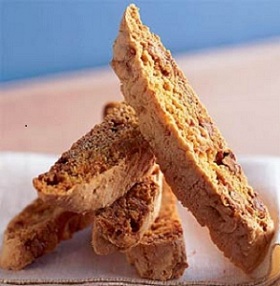Ingredients:
250g flour
150g sugar
2 eggs
1 teaspoon vanilla or almond extract
1 teaspoon baking powder
A pinch of salt
150g whole almonds (preferably unpeeled)
Grated zest of 1 orange (optional)
Prepare the dough:
Preheat the oven to 180°C.
In a large bowl, mix the flour, sugar, baking powder and salt.
Make a well in the centre and add the eggs, vanilla (or almond) extract and orange zest if using. Mix until smooth.
Fold the whole almonds into the dough.
Shape the loaves:
Divide the dough into two or three portions. On a lightly floured surface, roll each portion into 4-5cm wide sausages.
Arrange the sausages on a baking sheet lined with parchment paper, spacing them out to allow them to spread slightly.
First baking:
Bake the sausages for about 20-25 minutes, until lightly browned.
Remove from the oven and let cool for 10 minutes to make cutting easier.
Cut the biscotti:
Using a serrated knife, cut the sausages into diagonal slices 1 to 1.5 cm thick.
Second baking:
Arrange the slices flat on the baking sheet and return to the oven at 160°C. Bake for 10 minutes, turn them over, then bake for another 10 minutes to make them nice and crispy.
Cooling:
Let the biscotti cool completely on a rack before storing in an airtight container.
Origin of Biscotti:
The origin of the cantucci in the recipe without almonds dates back to the sixteenth century and the name seems to derive from canto ("angle", "corner") or from cantellus, that is, piece or slice of bread in Latin. The first description of cantuccini is found in the dictionary of the Accademia della Crusca which in 1691 gives the following definition: "sliced biscuit, made with fine flour, with sugar and egg white". The most famous cantucci of the time were produced in Pisa, as the naturalist Francesco Redi testifies in numerous exchanges of letters from the city. Redi used to accompany his missives with cantucci, found precisely in Pisa. He refers to it in his Book of Memories, which covers the years 1647 to 1697.

Comments
Post a Comment